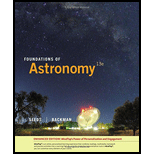
Concept explainers
According to the Aristotle, if earth and water were displaced then they would return naturally to their proper place. Today, what do we call this Aristotelean natural motion?
The name of the Aristotelean natural motion.
Answer to Problem 1RQ
The name of the Aristotelean natural motion is force of gravity.
Explanation of Solution
According to Aristotle model of universe, earth is situated in the centre of the planetary system.
Since the Earth is situated in the centre of the planetary system, the substances in the earth fall towards the centre of the earth. These motions are known as natural motions.
When an external force is applied to an object, the object will start moving. Also the object will stop eventually, when the external force is zero. This motion is known as violent motion.
Similarly, Aristotle proposed that the earth and water displaced by natural motion; they will come to their place naturally.
This natural motion is also explained by Galileo and Newton for different situation. And they named this force as force of gravity. Thus, due to gravitational force, objects are falling towards the centre of earth. Therefore, the natural force can be regarded as the gravitational force in modern day terms.
Want to see more full solutions like this?
Chapter 5 Solutions
Foundations of Astronomy, Enhanced
- Lab 8 Part 3 PHET Wave Interface simulation. I am having trouble with this part of the lab.arrow_forwardMick and Rick are twins born on Earth in the year 2175. Rick grows up to be an Earth-bound robotics technician while Mick becomes an intergalactic astronaut. Mick leaves the Earth on his first space mission in the year 2200 and travels, according to his clock, for 10 years at a speed of 0.75c. Unfortunately, at this point in his journey, the structure of his ship undergoes mechanical breakdown and the ship explodes. How old is Rick when his brother dies?arrow_forwardHi, I have canceled, why did you charge me again?arrow_forward
 Physics for Scientists and Engineers: Foundations...PhysicsISBN:9781133939146Author:Katz, Debora M.Publisher:Cengage Learning
Physics for Scientists and Engineers: Foundations...PhysicsISBN:9781133939146Author:Katz, Debora M.Publisher:Cengage Learning
 Glencoe Physics: Principles and Problems, Student...PhysicsISBN:9780078807213Author:Paul W. ZitzewitzPublisher:Glencoe/McGraw-Hill
Glencoe Physics: Principles and Problems, Student...PhysicsISBN:9780078807213Author:Paul W. ZitzewitzPublisher:Glencoe/McGraw-Hill AstronomyPhysicsISBN:9781938168284Author:Andrew Fraknoi; David Morrison; Sidney C. WolffPublisher:OpenStax
AstronomyPhysicsISBN:9781938168284Author:Andrew Fraknoi; David Morrison; Sidney C. WolffPublisher:OpenStax Foundations of Astronomy (MindTap Course List)PhysicsISBN:9781337399920Author:Michael A. Seeds, Dana BackmanPublisher:Cengage Learning
Foundations of Astronomy (MindTap Course List)PhysicsISBN:9781337399920Author:Michael A. Seeds, Dana BackmanPublisher:Cengage Learning Stars and Galaxies (MindTap Course List)PhysicsISBN:9781337399944Author:Michael A. SeedsPublisher:Cengage Learning
Stars and Galaxies (MindTap Course List)PhysicsISBN:9781337399944Author:Michael A. SeedsPublisher:Cengage Learning





